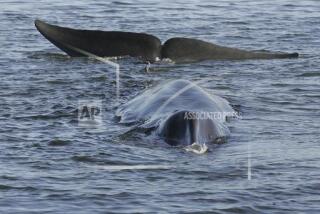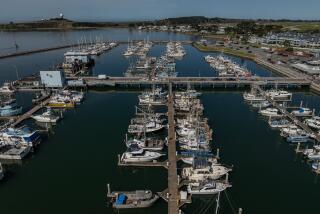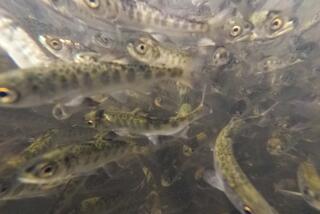Iceland Uses Fishing Quota to Protect Cod
- Share via
REYKJAVIK, Iceland — When Iceland’s cod catch plunged and the government imposed fishing quotas, schoolteacher Sveinbjorn Jonsson, true to his Viking heritage, took to the sea in his 40-foot boat full time to stake his claim.
Like most Icelanders, Jonsson has strong opinions about fish. Unlike most fishermen, he puts a home computer to work analyzing data about the fish he catches. And the data show that shrunken stocks of cod are growing slowly around this North Atlantic island.
“If we look at the ocean as a farm, then we should concentrate on being good farmers. We have been bad farmers,” Jonsson said.
Iceland is in the forefront of nations that are moving from catching all the fish they can to monitoring fish populations and catching a set percentage, or quota.
New Zealand and Norway claim success with quotas. Controls are also credited with the rebound of salmon off Alaska. And many scientists believe other fishing nations should adopt quotas to guard against overfishing and irreversibly depleting world stocks.
For this rockbound nation of 266,000, cod is the most important stock, accounting for about a third of its earnings from the sea. But despite 12 years of quotas, the cod catch is rising only slowly.
It peaked above 500,000 tons in 1953-55, then fell steadily until 1985, when the government imposed limited quotas. The catch continued to fall, hitting a 50-year low of 169,428 tons in 1995, when much tighter controls took effect.
The quotas apply to cod and two dozen other fish species in Iceland’s 200-mile offshore economic zone, where only Icelanders are allowed to fish.
The government has approved a cod catch of 218,000 tons for the year beginning this September, allowing fishermen to harvest what scientists believe is about 25% of the overall stock of breeding cod in Iceland’s cold waters. Before 1995, fishermen were allowed to take 40% of the estimated stock, a rate scientists now believe was too high.
“I think that we are at the turning point. We are beginning to see positive results,” said Jakob Jakobsson, who as director of Iceland’s Marine Research Institute has a key word in monitoring the catch and setting quotas.
Jakobsson draws confidence from the recovery of herring, which virtually disappeared off Iceland in the 1970s, dropping from a high catch of 770,000 tons in 1966 to 28,925 tons in 1977. Quotas have helped the herring harvest recover to 260,833 tons this year.
When fish are plentiful, Iceland thrives. When fish disappear, Iceland suffers.
Fishing accounts for 55% of Iceland’s total exports, 18% of its gross national product and 11% of its jobs. Fishing drives the retail, service and construction sectors as well.
“It is the thing that is keeping us going,” said Arni Kolbeinsson, secretary-general of the Fishing Ministry.
It has kept Jonsson, 47, going since he quit his teaching job in the mid-1980s, when quotas were instituted. To qualify for a quota, he had to work his fishing boat full time.
He now fishes off fjords not far from his home in Sudureyri, a collection of red and blue roofs in Iceland’s northwest, set amid dark basalt cliffs just below the Arctic Circle.
The village population has shrunk from 500 to 300 people since quotas were imposed because, Jonsson says, the catch is being consolidated in the hands of large boat owners.
Big operators are buying out the quotas of small fishermen, shifting to “factory” ships that process the catch at sea, and forcing the shutdown of onshore processing plants. In the end, the quota sales threaten traditional Icelandic family fishing, Jonsson maintains.
“I think that the quota system has been very harmful. I don’t think that the government should be allowed to do what ours has done,” he said. “It’s a question of selling freedom.”
If the cod had bounced back strongly with quotas, the disappearance of an Icelandic way of life might be tolerable, he said.
“Cod used to run 600,000 tons in the best years. Now 218,000 is allowed. This is hardly a success story.”
A spokesman for the big operators contends, however, that the Icelandic industry is changing not just because of quotas, but because of a changing world market that encourages mass production.
Sticking to the quotas “is a bit of a gamble,” said Kristjan Rajnarsson, president of the association representing large boat owners. “We have to keep the quotas low, and keep patient.”
He and others say the cod stocks are recovering relatively slowly because--for reasons not fully understood--breeding production has been no better than average since the quotas took effect. Scientists and fishermen are waiting for a banner breeding year to boost the cod population.
The fact is scientists know relatively little about fish, which live hidden lives in the depths until they land flopping on the deck.
“Fish are very hard to study,” says Jakobsson, who has spent his life at it. “And sometimes they give you a bad surprise.”
More to Read
Sign up for Essential California
The most important California stories and recommendations in your inbox every morning.
You may occasionally receive promotional content from the Los Angeles Times.










